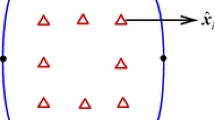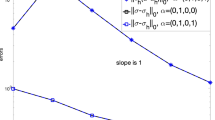Summary
Based on boundary displacement and traction, a non-hypersingular boundary integral formulation is developed for the displacement gradient. At an arbitrary boundary point where the displacement field at least satisfies a Hölder condition (u k∈C 1, γ with γ>0), the displacement gradient can be calculated by the Cauchy Principal Value (CPV) integration. The hypersingularity involved in conventional formulation is circumvented by applying rigid body translation. The numerical implementation of the present formulation is illustrated, and both direct and indirect approaches are discussed. For two-dimensional problems, the coefficients involved in the direct approach are analytically derived. The stress formulation is also discussed. Finally, numerical examples are presented to validate the present formulation.
Similar content being viewed by others
References
Rizzo, F. L.: An integral equation approach to boundary value problems of classical elastostatics. Q. Appl. Math.25, 83–95 (1967).
Cruse, T. A.: Numerical solutions in three-dimensional elastostatics. Int. J. Solids Struct.5, 1259–1274 (1969).
Cruse, T. A., Vanburen, W.: Three-dimensional elastic stress analysis of a fracture specimen with an edge crack. Int. J. Fract. Mech.7, 1–15 (1971).
Fiedler, C.: On the calculation of boundary stresses with Somigliana stress identity. Int. J. Numer. Meth. Eng.38, 3275–3295 (1995).
Rizzo, F. J., Shippy, D. J.: A formulation and solution procedure for the general nonhomogeneous elastic inclusion problem. Int. J. Solids Struct.4, 1161–1179 (1968).
Ghosh, N., Rajiyah, H., Ghosh, Mukherjee, S.: A new boundary element method formulation for linear elasticity. J. Appl. Mech.53, 69–76 (1986).
Barone, M. R., Yang, R. J.: Boundary integral equations for recovery of design sensitivities in shape optimization. AIAA J.26, 589–594 (1988).
Guiggiani, M.: Hypersingular formulation for boundary stress evaluation. Eng. Anal. Boundary Element13, 169–179 (1994).
Guiggiani, M.: Hypersingular boundary integral equations have an additional free term. Comp. Mech.16, 245–248 (1995).
Ghosh, N., Mukherjee, S.: A new boundary element method formulation for three dimensional problems in linear elasticity. Acta Mech.67, 107–119 (1987).
Okada, H., Rajiyah, H., Atluri, S. N.: A novel displacement gradient boundary element method for elastic stress analysis with high accuracy. J. Appl. Mech.55, 786–794 (1988).
Hartmann, F.: Computing C-matrix in non-smooth boundary points. In: New developments in boundary element methods (Brebbia, C. A., ed.), pp. 367–379. London: Butterworths 1980.
Lachat, J. C., Watson, J. O.: Effective numerical treatment of boundary integral equations: a formulation for three-dimensional elastostatics. Int. J. Numer. Meth. Eng.10, 991–1005 (1976).
Rizzo, F. J., Shippy, D. J.: An advanced boundary integral equation method for three-dimensional thermoelasticity. Int. J. Numer. Meth. Eng.11, 1753–1768 (1977).
Watson, J. O.: Advanced implementation of the boundary element method for two- and three-dimensional elastostatics. In: Developments in boundary element method — I, (Banerjee, P. K., Butterfield, P., eds.), pp. 31–63. London: Applied Science Publishers 1979.
Hadamard, J.: Lectures on Cauchy's problem in linear partial differential equations. New Haven: Yale University Press 1923.
Krishnasamy, G., Schmerr, L. W., Rudolphi, T. J., Rizzo, F. J.: Hypersingular boundary integral equations: some applications in acoustic and elastic wave scattering. J. Appl. Mech.57, 404–414 (1990).
Guiggiani, M., Krishnasamy, G., Rudolphi, T. J., Rizzo, F. J.: A general algorithm for numerical solution of hypersingular boundary integral equations. J. Appl. Mech.59, 604–614 (1992).
Gray, L. J., Soucie, C. S.: A Hermit interpolation algorithm for hypersingular boundary integrals. Int. J. Numer. Meth. Eng.36, 2357–2367 (1993).
Mukherjee, S., Toh, K. C.: Hypersingular and finite part integrals in the boundary element method. Int. J. Solids Struct.31, 2299–2312 (1994).
Guiggiani, M., Casalini, P.: Direct computation of Cauchy principal value integrals in advanced boundary element methods. Int. J. Numer. Meth. Eng.24, 1711–1720 (1987).
Guiggiani, M., Gigante, P.: A general algorithm for multidimensional Cauchy principal value integrals in the boundary element methods. J. Appl. Mech.57, 906–915 (1990).
Zhang, Q., Mukherjee, S.: Design sensitivity coefficients for linear elastic bodies with zones and corners by the derivative boundary element method. Int. J. Solids Struct.27, 983–998 (1991).
Author information
Authors and Affiliations
Rights and permissions
About this article
Cite this article
Dong, Y.F., Gea, H.C. A non-hypersingular boundary integral formulation for displacement gradients in linear elasticity. Acta Mechanica 129, 187–205 (1998). https://doi.org/10.1007/BF01176745
Received:
Revised:
Issue Date:
DOI: https://doi.org/10.1007/BF01176745




